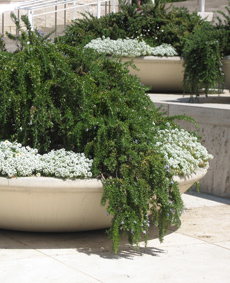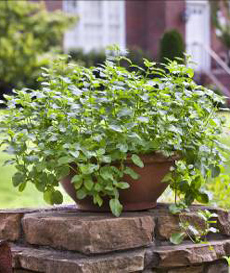TIP OF THE DAY: Grow Some Mint ~ You’ll Find Plenty Of Uses For It
 Jumbo rosemary planters at the Getty Museum in Los Angeles (the white flowers are and allysum. Photo courtesy GardenSnob.com. |
Last night we tried a new restaurant. At the table, folded into our napkin, was a sprig of rosemary. There was a sprig of rosemary in our water glass. The food we ordered came garnished with rosemary. “There must have been a sale on rosemary this week,” we said to our companion. “No,” he said, “the planters out front are full of it.” We looked, and rosemary was indeed growing high in terra cotta pots on the outdoor patio. Had we been moving so quickly that we forgot to stop and smell the rosemary? We decided to hunt down a rosemary plant this weekend, to see how many different things we could do with the sprigs. Then, we received a tip on growing mint that caused us to switch gears. We’ll get to the rosemary later; today’s tip is an encouragement to use more mint—and different types of mint. The mint you plant will soon bear enough leaves to keep you in beverages (including cocktails), desserts, salads, soups and garnishes for the entire growing season. |
|
|
TYPES OF MINT Much of what you find in the market is spearmint. But there are other wonderful varieties of mint to enhance your cooking: Head to your gardening store. Mints are fast-growing, spreading plants. You need to give them room to grow outdoors, or you can contain them in a pot—outdoors or indoors. Mints send out runners that spread above and just under the ground, quickly forming large, lush green patches. In the right place, mint makes a sensational, seasonal ground cover. You can also contain mint in tight places such as between pavers of a walkway. Mint perfumes the air wherever it is planted: It delivers an aromatic treat each time you walk past it. Here are mint-growing tips from Bonnie Plants, a national plant wholesaler committed to green gardening. The company makes eco-friendly gardening products and biodegradable peat pots and fiber pots that have already prevented millions of pounds of plastic from entering landfills. |
||
|
MINT GROWING TIPS 1. POT IT. The most popular way to grow mint is in a pot where you can keep it contained and handy near the kitchen for a constant supply of sprigs. Choose a potting mix that retains water to be sure soil stays moist. 2. PLANT IT. If you have outdoor space, select a damp area in your garden in either full sun or partial shade. Mint prefers fertile soil with a pH from 6.0 to 7.0. It is vigorous on its own but will appreciate a little fertilizer every few weeks, especially if you harvest a lot of mint. You can also mulch around the plants to keep roots moist; plants will die back in dry soil. Keep plants in check by harvesting the tips regularly and pulling up wayward runners in the garden. Mint’s small flowers bloom from June to September. Trim them before the buds open to keep the plant compact. |
 A pot of mint ornamenting the front lawn. It can also grow inside. Photo courtesy BonniePlants.com. |
|
|
WHAT TO DO WITH YOUR BOUNTY OF MINT When cooking with mint, it’s best to use the leaves. Mint stems are tougher than leaves and not as flavorful. For more info and tips on mint and other herbs visit BonniePlants.com.
|
||


